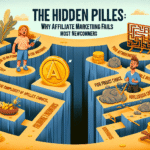The concept of passive income has received significant attention over the last few years, becoming a popular goal for individuals seeking financial independence and stability. As we look ahead to 2025, advances in technology and changes in consumer behavior are shaping the future of passive income opportunities. This article explores emerging strategies that individuals can consider to build sustainable passive income streams in the coming years.
What is Passive Income?
Passive income refers to earnings derived from investments or ventures that require little to no daily effort to maintain. Unlike active income, which involves exchanging time for money (such as a traditional job), passive income allows individuals to earn revenue with minimal ongoing work. This can include income from rental properties, dividend stocks, royalties from intellectual property, or income-generating online businesses.
Why Focus on Passive Income in 2025?
With rising living costs, economic fluctuations, and the growing desire for financial independence, passive income is becoming increasingly attractive. In 2025, factors to consider include:
- Technology Advancements: The growing use of AI and automation will streamline investment processes and enhance the monetization of various assets, making it easier for individuals to develop passive income streams.
- Increased Connectivity: The proliferation of digital platforms ensures that individuals can access new markets, facilitate online sales, and reach global audiences.
- Shifts in Employment Norms: The gig economy and remote work options are leading more individuals to seek alternative revenue sources beyond their primary jobs.
Top Passive Income Strategies for 2025
As we look forward to 2025, several passive income strategies are poised to offer viable pathways for individuals to generate earnings with less ongoing effort.
1. Real Estate Crowdfunding
Real estate has always been a popular avenue for passive income, but crowdfunding platforms like Fundrise and RealtyMogul are democratizing access to real estate investments. Investors can pool their resources to fund multi-family properties, commercial projects, or real estate development. By 2025, fractional ownership models will make it even easier to invest in real estate without large upfront costs.
2. Dividend Stocks and ETFs
Investing in dividend-paying stocks and Exchange-Traded Funds (ETFs) can offer reliable passive income through regular dividend payments. As companies continue to prioritize shareholder returns, diversifying across various sectors can provide stability and reduce risk. In 2025, investors will have access to more diversified funds that focus on sustainability and ESG (Environmental, Social, and Governance) metrics.
3. Digital Products and Online Courses
The demand for digital products is on the rise, as consumers continue to seek knowledge and skill development. By creating online courses, e-books, or membership sites, individuals can earn income from content they create once and sell repeatedly. Platforms like Udemy, Teachable, and Gumroad provide tools to facilitate this process.
4. Affiliate Marketing and Blogging
Creating niche blogs or websites that generate traffic through valuable content can lead to significant passive income via affiliate marketing. By promoting third-party products and earning commissions on sales, individuals can build a sustainable income stream. In the coming years, the rise of AI-driven content generation tools will enable aspiring bloggers to create high-quality content with less effort.
5. Automated eCommerce
The trend toward eCommerce is not slowing down. By 2025, advancements in AI and automation will streamline the eCommerce process, allowing individuals to engage in dropshipping, print-on-demand, or automated fulfillment without the need for inventory management. Integrating AI chatbots and marketing automation tools can enhance customer engagement and increase sales with minimal effort.
6. Peer-to-Peer Lending
Peer-to-peer lending platforms such as LendingClub and Prosper enable individuals to lend money directly to borrowers and earn interest on the loans. As trust in these platforms has grown, so has the demand for alternative financing solutions. By 2025, advancements in blockchain technology may further increase transparency and security in peer-to-peer lending.
7. High-Yield Savings Accounts and Robo-Advisors
As interest rates fluctuate, securing high-yield savings accounts or utilizing robo-advisors can provide a reliable passive income stream through interest earnings and investment growth. Robo-advisors, powered by algorithms, allow individuals to invest their money according to their risk tolerance and financial goals without manual management.
8. Intellectual Property Rights
Creative individuals can generate income through royalties by licensing their intellectual property, such as music, patents, or artwork. As digital platforms evolve, artists and creators will have more opportunities to monetize their work, with potential growth in non-fungible tokens (NFTs) providing additional avenues for passive income in the creative economy.
Conclusion
The future of passive income looks promising, with a range of strategies becoming increasingly accessible due to technological advancements and changing consumer behaviors. As we approach 2025, individuals seeking financial independence must explore these emerging opportunities, invest wisely, and remain adaptable to shifts in the economic landscape. Building a diversified portfolio of passive income streams can lead to increased financial stability, allowing individuals to focus on their passions and achieve their life goals.
[ad_2]If you’re intrigued by exploring the realm of passive income, you might find the concept of financial independence particularly fascinating. This approach emphasises building investments that allow you to live without relying on a traditional salary. Moreover, understanding dividend payments can enhance your knowledge of generating income from stocks and shares, a favoured method among investors. With the rise in demand for digital products, there’s potential to leverage your skills by creating content that can be sold with minimal ongoing effort. Lastly, diving into the world of affiliate marketing could open up opportunities for earning commissions by promoting various brands and products online. All these strategies represent the evolution of passive income, driven by dynamic technological and consumer trends.





